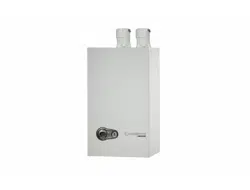Loading ...
Loading ...
Loading ...

Part number 550-100-325/0419
15
AquaBalance
®
Series 2 Wall Mount Gas-fired Water Boiler – Boiler Manual
6 Venting/air piping — general
Any improper operation of the common venting system should
be corrected so the installation conforms with the National Fuel
Gas Code, ANSI Z223.1/NFPA 54, and/or the Natural Gas and
Propane Installation Code, CAN/CSA B149.1. When resizing
any portion of the common venting system, the common vent-
ing system should be resized to approach the minimum size as
determined using the appropriate tables in Chapter 13 of the
National Fuel Gas Code, ANSI Z223.1/NFPA 54, and/or the
Natural Gas and Propane Installation Code, CAN/CSA B149.1.
Do not install the boiler into a common vent
with any other appliance. This will cause flue
gas spillage or appliance malfunction, resulting
in possible severe personal injury, death or sub-
stantial property damage.
Existing common vent systems may be too large
for the appliances remaining connected after the
existing boiler is removed.
Failure to follow all instructions can result in
flue gas spillage and carbon monoxide emissions,
causing severe personal injury or death.
When removing a boiler from an
existing common vent system
-
. When an existing boiler is replaced with a boiler, the boiler
CANNOT use the existing common vent. The boiler requires its
own vent and air piping, as specified in this manual. This may cause
a problem for the appliances that remain on the old common vent,
because the vent may be too large. The following test is intended
to check for proper operation of the appliances remaining on the
old common vent system.
Perform the test sequence below for appliance remaining on
the original common vent system. Operate each appliance indi-
vidually, with other appliances turned off. This procedure will test
whether the common vent system can properly vent each appliance.
Existing vent test procedure
(The following is intended to test whether the appliances
remaining on an existing vent system will operate
satisfactorily.)
1. Seal any unused openings in the common venting system.
2. Visually inspect the venting system for proper size and hori-
zontal pitch and determine there is no blockage or restriction,
leakage, corrosion or other deficiencies which could cause an
unsafe condition.
3. Test vent system — Insofar as is practical, close all building
doors and windows and all doors between the space in which
the appliances remaining connected to the common venting
system are located and other spaces of the building. Turn on
clothes dryers and any appliance not connected to the com-
mon venting system. Turn on any exhaust fans, such as
range hoods and bathroom exhausts, so they will operate
at maximum speed. Do not operate a summer exhaust fan.
Close fireplace dampers.
4. Place in operation the appliance being inspected. Follow
the operating instructions. Adjust thermostat so appliance
will operate continuously.
5. Test for spillage at draft hood relief opening after 5 minutes
of main burner operation. Use the flame of a match or
candle, or smoke from a cigarette, cigar, or pipe.
6. After it has been determined that each appliance remaining
connected to the common venting system properly vents
when tested as outlined herein, return doors, windows,
exhaust fans, fireplace dampers, and any other gas-burning
appliance to their previous conditions of use.
Loading ...
Loading ...
Loading ...
